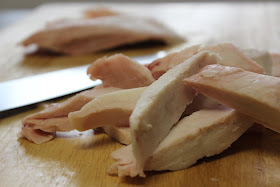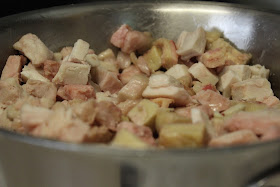News flash. Saturated fat is good for you. Like really good for you. The ultimate superfood. Seriously, give me a slab of butter over acai berries any day. I know this may come as a shock to some of you. In the last few decades, we have been led to believe that fat was the enemy, and saturated fat was something to avoid like the plague. As a society, we ditched the animal fats, like lard, tallow, and butter, and started consuming processed vegetable oils, shortenings, and margarine. Study after study seemed to prove that saturated animal fats caused a myriad of health issues and that we were better off using these new-fangled, highly processed substitutes. Like most people, I bought into this way of thinking for a long time. It wasn't until I began my real food journey that I realized how wrong I'd been. Undergoing an "oil change" was the single most influential dietary decision I've ever made. My diet has always consisted of real, whole foods with plenty of fruits, veggies, and protein but my choices regarding fats and oils were misguided, uninformed, and extremely detrimental.
Go back a hundred years, and you'd find lard and tallow in every kitchen. Go back a hundred years and you'd also find almost no obesity, heart disease, or diabetes. Coincidence? Hardly. Even the Golden Arches used to use tallow to fry their French fries until 1983 when they eventually switched to soybean oil. Vegetable oils like canola, soybean, and cottonseed are cheap and plentiful, the perfect recipe for processed food manufacturers. Unfortunately in America, the driving force behind our food supply is not the health of the people, but the almighty dollar. Food manufacturers care more about their pockets than our waistlines and well being. Consequently, cheap and dangerous vegetable oils replaced nourishing, time and labor intensive animal fats and we are all paying the price.
Saturated fats, like the ones found in coconut, butter, avocado, and meats play an integral role in every single bodily function. To gain a little perspective on how vital these fats are, we need to look no further than Nature's perfect food, breast milk. It's composition is 54% saturated fat, and no one could argue that is by mistake. Need more convincing? Each one of our cells are comprised of 50% saturated fat. Yes, you read that right. Half of our cell membrane's structure is saturated fat. Simply put, our bodies cannot function without it.
But wait. Animal fats are bad for us, right? If you listen to the FDA, you may believe so. In recent years, animal fats have been demonized, being blamed for everything from heart disease to high cholesterol. Turns out they were wrong. What? The government wrong about something? Say it isn't so. Recent studies have shown that contrary to previously stated evidence, higher saturated fat intake is associated with lower incidences of coronary heart disease deaths. You can read more about the benefits of saturated fats and the detriments of vegetable oils here, here, and here. Animal fats like lard and tallow, especially if sourced from pastured animals have a veritable smorgasbord of health benefits including, but not limited to:
- Providing energy and structural integrity to cells
- Grass-fed tallow is high in CLA, a type of fat that actually burns fat. CLA can reduce body fat and increase muscle mass
- Enhancing the immune system
- Building and strengthening bones and teeth (preventing cavities and osteoporosis)
- Protecting the liver, maintenance of skin and hair and vital for proper brain function
- Enhancing the body’s use of essential fatty acids
- Lowering bad cholesterol (LDL) and increasing good cholesterol (HDL)
- Increased tolerance to the sun (less burning)
- Increased energy levels
- Improved sleep
- Decrease in food cravings
- Necessary for absorption of vitamins A, K, D, and E
- Are extremely shelf stable and do not become rancid easily
- Do not call upon the body’s reserves of antioxidants
- Do not initiate cancer
- Soothe artery walls
In addition to these benefits, animal fats also:
I can't stress this point enough: Our bodies are designed to burn fat as fuel, but to do so, we have to increase our consumption of healthy fats and reduce our intake of refined carbohydrates and sugars! Eat fat to burn fat as I like to say. Even my own husband is shocked by the amount of fat I eat and my ability to stay in tip-top shape. I keep trying to tell him, fat is the reason I am thin. I realize this sounds so contradictory, but my body is truly fat adapted, meaning I can consume copious amounts of butter and endless slices of avocado without the slightest worry that I might start packing on the pounds. The only caveat here is that you must limit your refined, processed carbohydrate intake. Period. End of story. As long as you follow these guidelines, you not only drastically reduce the likelihood of contracting a number of health related diseases, but you get to enjoy food with lots of flavor, all while staying slim. It doesn't get much better than that. You literally get to have your bacon and eat it too.
I'm going to be presumptuous and assume that by now you have jumped on the animal fat bandwagon. The mounting evidence in favor of fats plus the tantalizing thought of potatoes fried in tallow have you ready to start rendering. Good news, it couldn't be any easier to make tallow. Plus, there is something so primal and therapeutic about running your knife through a thick piece of creamy fat. Or maybe that's just me...:)
Step one. Gather your fat. Suet, the fatty layer around the kidneys, is the best if you can get it, but pretty much any hard fat will do. Preferably you want your fat to come from grass-fed, pastured animals as these will have the highest concentrations of valuable fatty acids, although I'd take tallow from conventionally raised animals over vegetable oils any day.
Step two. Place fat in freezer for a few hours. This will make it a breeze to cut.
Step three. Trim off any meat left on the fat and cut into small pieces or place in food processor.
Step four. You have three options here. All work well, but I prefer the stove top or crock pot.
Stove top and crock pot version:
- Put fat in large, heavy bottomed pot or crock pot.
- Turn on heat to lowest setting.
- Cover and cook for 1-2 hours or until there is mostly golden liquid with hard bits floating on top.
- Strain rendered fat through cheesecloth or coffee filter over a mesh strainer into a mason jar.
Oven version:
- Put fat into Dutch oven or other oven safe pot.
- Turn oven on to 200 degrees.
- Cook until you are left with mostly golden liquid and hard bits floating on top.
- Strain fat through cheesecloth or coffee filter over a mesh strainer into a mason jar.
Tallow will turn a creamy white when hardened and last about a year in the fridge. You now have a healthy, stable, high heat fat to cook and fry with! In our house it doesn't get much better than sweet potatoes fried in tallow or veggies roasted in this delicious fat.
Making tallow soap or lotion is next on my to-do list. What are your favorite uses for tallow?




Cant still bring myself to eating the fat of the animal, but I am interested on how to we know the meat we buy is tall grass fed.
ReplyDeletethanks :)
I urge you to make the transition to eating animal fat, it is the fat that sustained our species for millennia. Not to mention, it makes everything taste so good! As for sourcing grass fed meat, the best bet is to find a local farmer or butcher that you can establish a relationship with. Aside from that, farmer's market's are a great place to find pastured animals, and most grocery stores now carry some form of grass fed beef, even Costco! Hope I've inspired you to make the switch to quality protein and more importantly, quality animal fats!
Delete